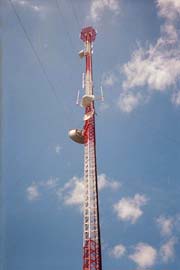You Can Hear Me Now: Software Brings Cellular Capacity To Rural Communities

Communications tower in DeLeon, Texas. The base station at the foot of the tower is the host for the Vanu Software Radio testbed. <br>Credit: Vanu, Inc. and Mid-Tex Cellular; National Science Foundation
Researchers have successfully tested a system that can replace a cellular tower’s room full of communications hardware with a single desk-top style computer, making the technology affordable for small, rural communities.
The software is also capable of running emergency communications-such as police, fire and ambulance channels-on the same device as the civilian system, eliminating the need for a separate network of emergency communications towers.
“Rural customers are the first application of the technology, but large carriers are watching to see what happens,” said John Chapin, chief technology officer at Vanu, Inc., the Cambridge, Mass. Company that tested and markets the software, which it calls Vanu Software Radio(tm).
Vanu scientists developed and tested the software with funds from the National Science Foundation (NSF), the independent federal agency that supports fundamental research and education across all fields of science and engineering.
“There is an economic driver to the small business projects, and both NSF and awardees have to be flexible,” said Sarah Nerlove, the NSF Small Business Innovation Research (SBIR) program officer who oversees Vanu’s awards. “When the telecom industry crashed, Vanu technology caused wireless operators to look at deployments differently. Vanu was an ideal fit for their changing needs,” she added.
NSF awards SBIR grants to small businesses for risky, novel research with a potential for commercialization. Through SBIR and the related Small Business Technology Transfer (STTR) programs, NSF encourages partnerships between the small business and the academic sectors to develop a technology base for commercialization.
Cellular towers now dot the landscapes of cities and suburbs, providing millions of Americans with access to wireless communications. Currently, at the base of each tower is an air conditioned shelter filled with expensive equipment called a basestation.
“As technology advances, all of that equipment continually needs to be overhauled or replaced,” said John Chapin, chief technology officer at Vanu. In addition to replacing much of the equipment with a single computer server, radio software can aggregate the equipment from many stations into a single location into what communications engineers call a “basestation hotel,” he said.
Vanu Software Radio(tm) is first of its kind to perform all functions of a GSM (a digital cellular standard) base station using only software and a non-specialized computer server. The servers run the Linux operating system on Pentium processors, further simplifying the technology and reducing cost.
The company successfully demonstrated the technology in two rural Texas communities: De Leon in Comanche County and Gorman in Eastland County. When the test ends, the technology will remain as a cellular infrastructure run by Mid-Tex Cellular, Ltd.
“The overall system is much cheaper and therefore offers opportunities to underserved rural areas,” said Vanu basestation engineer Jeff Steinheider who led the technology installation in Texas.
Although the software currently runs on larger servers using a Linux operating system, the software also runs on a variety of commercial computers, so cellular service providers can run the product on economical systems. And, according to Chapin, the software’s portable design easily adapts to hardware upgrades. Even a personal computer could run Vanu waveform software, he said, although it could not handle a large number of customers.
The software has been successfully carrying phone calls since it was installed in the Texas towns in June 2003. The researchers have been tracking how many calls successfully go through, how well mobile phones communicate with other mobile phones and how well mobile phones communicate with landline phones.
So far, the results have been positive and by early 2004, the system is expected to become fully operational for Mid-Tex cellular customers.
Potentially, large carriers could also use the software to establish base station hotels or upgrade and condense their existing equipment. Beyond that, the technology will allow cellular providers to more efficiently use the frequency spectrum reserved for communication and are more flexible if they need to be upgraded to handle even more bandwidth, said Chapin.
Media Contact
More Information:
http://www.nsf.govAll latest news from the category: Communications Media
Engineering and research-driven innovations in the field of communications are addressed here, in addition to business developments in the field of media-wide communications.
innovations-report offers informative reports and articles related to interactive media, media management, digital television, E-business, online advertising and information and communications technologies.
Newest articles

Self-Destructing Cancer Cells: Cutting-Edge RNA Breakthrough
Jülich scientists use novel RNA technology to selectively switch off tumours in the brain. An Adaptable Platform Technology That Destroys Glioblastoma Cancer Cells Using a special RNA molecule, a team…

Endurance Training: Transforming Lives of Heart Failure Patients
Can strength and endurance training be beneficial for patients with a certain form of heart failure? A research team from Greifswald investigated this question together with seven other research centers…

A Wake-Up Call for Mediterranean Shark Protection Against Extinction
Overfishing, illegal fishing and increasing marketing of shark meat pose significant threats to the more than 80 species of sharks and rays that inhabit the Mediterranean Sea, according to a…



